Annual vines are some of the hardest working, best problem solving plants in the summer garden. And with a grow habit so vigorous, when warm days turn to hot days and warm nights, you can almost watch them grow in front of your eyes.
Vines are great for screening the less attractive bits in our gardens: an unsightly fence, big ol’ telephone pole or maybe the nosy neighbors. They also help draw the eye up and soften expanses of walls and siding. And unlike perennial vines, they do it all in one season rather than requiring that pesky patience part of gardening. They can also be removed or cut back entirely at the end of the season, which is helpful if you need to have clear areas for winter for access or snow removal.
Annual vines are also well suited to growing with perennial vines. In that first year when a perennial vine like my beloved clematis seems to just hang around doing very little of anything, growing an annual vine up the same trellis gives you first-year color and coverage without affecting the perennial vine’s future growth.
Vines can be expensive to buy as plants, but there are so many that are easy to grow from seed. Most of them want full sun, regular feeding and consistent moisture, all needed for the huge amounts of growth they have to put in in just weeks. Here are a few of my favorites.
THUNBERGIA
You might know it as black-eyed susan vine, but with so many new varieties available that have little resemblance to the bright yellow flowers associated with the common name, I favor calling this one by its botanical name. These are major growers! I’ve even seen garden centers warn people to not plant them in a container with anything else. That’s a bunch of hooey if you ask me, as containers are Thunbergia’s highest calling.
The interesting thing about Thunbergia is that once it gets to the top of whatever you use as support, it starts going back down, so it works really well in hanging baskets where it will cover the hanging bits of the structure. It also has small leaves, so even when it’s not flowering, it’s attractive.
It doesn’t, however, get entirely covered in flowers like some of these vines. That’s fine with me, but I think most of the time you’ll end up with more foliage than flowers. My favorite seed-grown varieties are Susie White with Eye (catchy, huh?) and Blushing Susie, which is lovely shades of pink to apricot, with those great dark centers.
Proven winners also offers three great performers in orange, yellow and an orange and yellow striped variety.
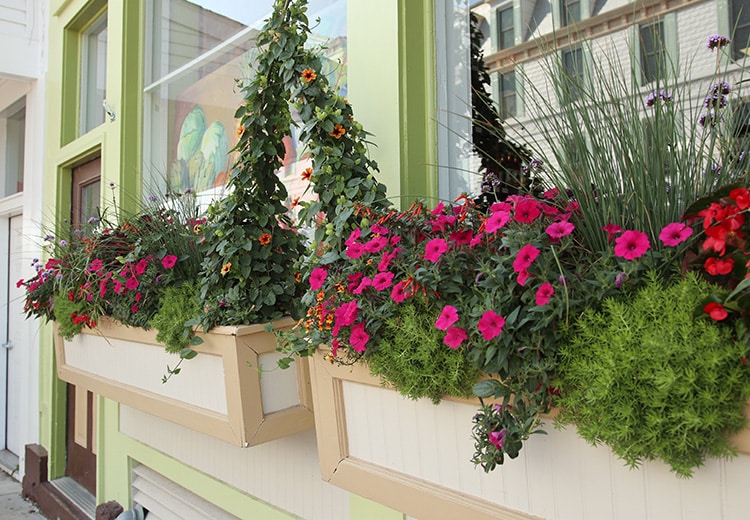
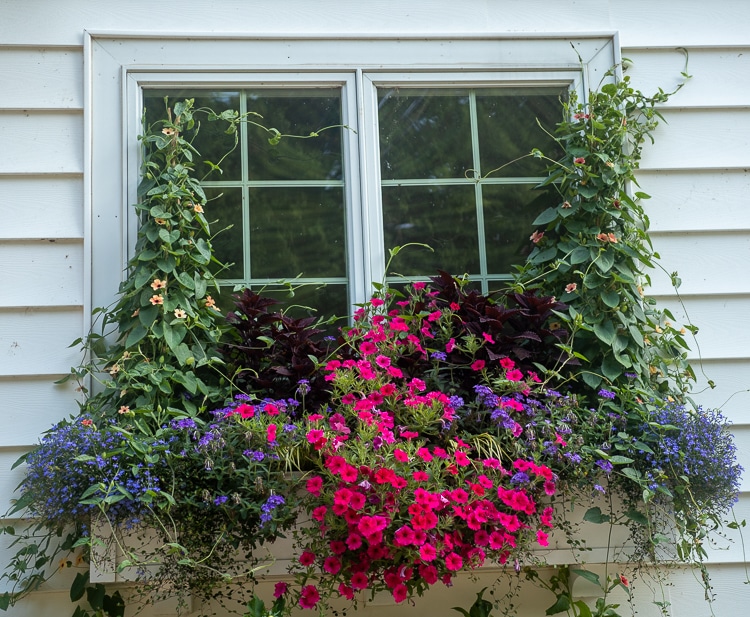
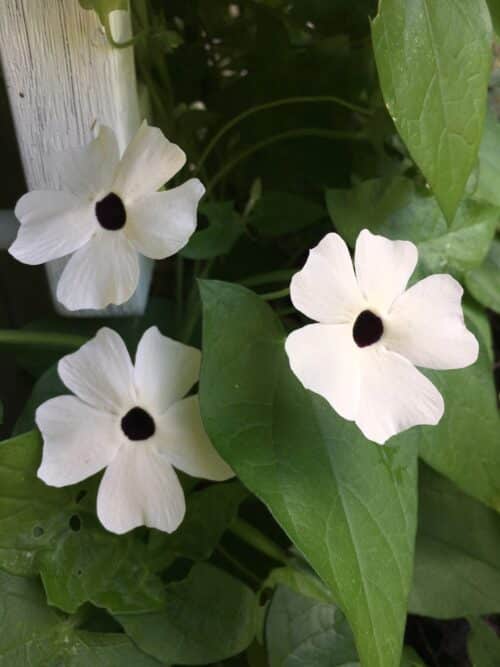
CUP AND SAUCER VINE
I grew cup and saucer vine (Cobaea scandens) for the first time last year, both the white and purple varieties. It took a long time to get blooms on it, but when it did, it was so, so good. This is also the only vine I’ve ever grown in the deck planters that has gotten big enough to actually start making its way across the pergola, rather than just up the post. Give this baby room to grow, then step back and watch it go.
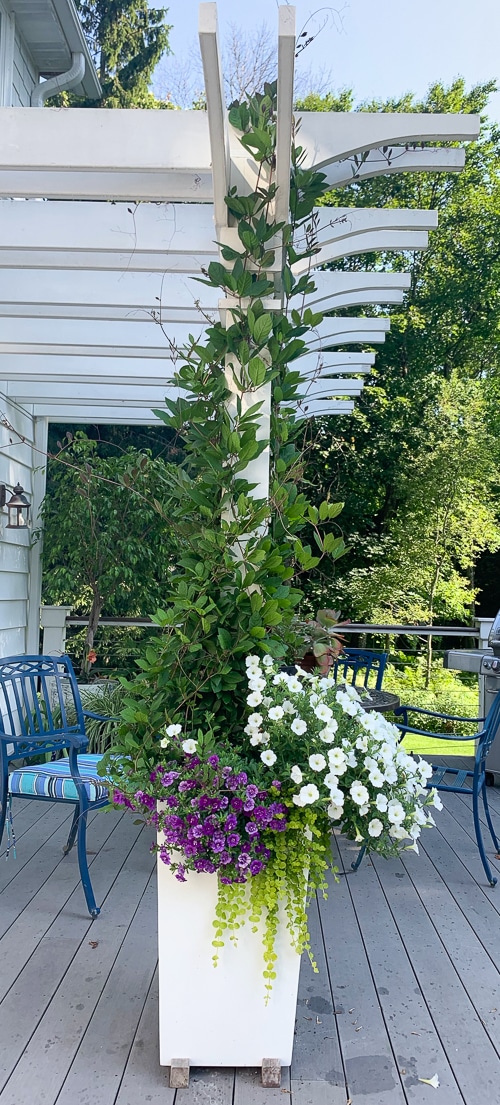
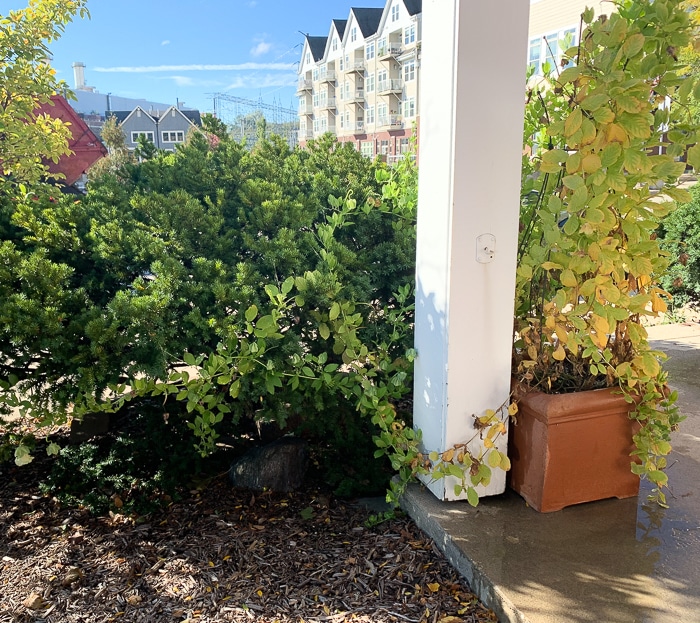
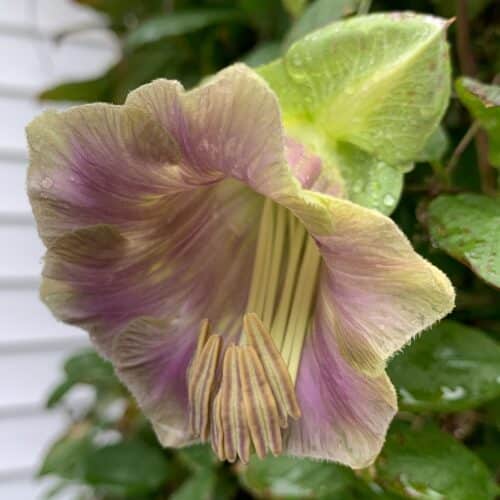
HYACINTH BEAN VINE
What a delight it was to grow hyacinth bean vine aka Dolichos lablab last year. I didn’t even give it a fair trial because I grew it in the trough by the garage, which gets almost no direct sun but lots of bright indirect light. I can only imagine how great it would have been if it had been in full, hot sun. Even in the conditions I subjected it to, it performed well.
It has beautiful, three-lobed leaves with purple veins (that you only really see up close), so it’s pretty even before it flowers. And its flowers are a lovely pink on deep purple stems with purple calyxes. And when the flowers are gone there are gorgeous dark purple bean pods, that you should probably really cut off to promote flowering, but they are equally beautiful. I like the ‘Ruby Moon’ variety I grew last year, but there are several varieties to experiment with.
I’m pretty sure I’ll grow this one in the deck containers this year.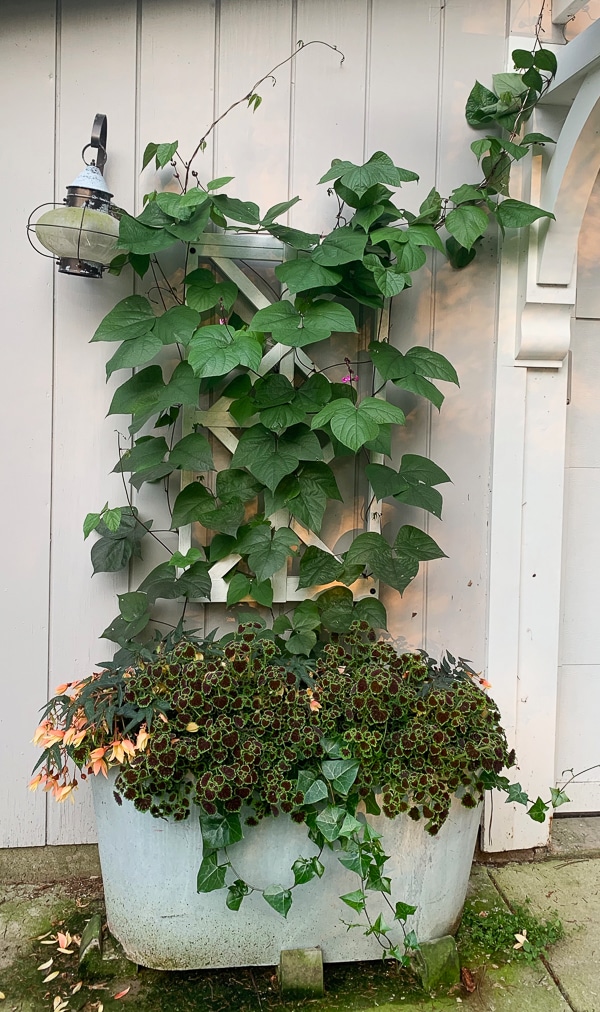
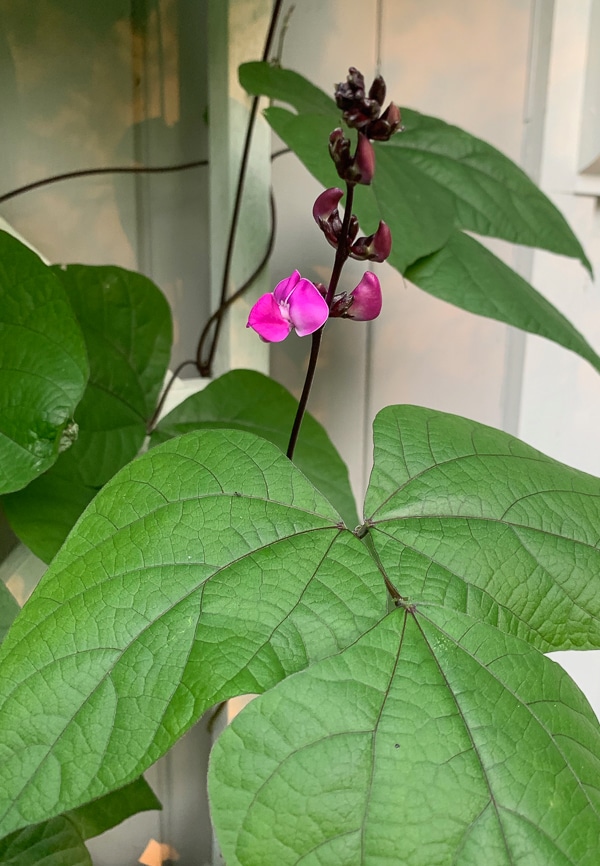
MANDEVILLA
Mandevilla was my gateway vine. I mean, how can you resist those gorgeous flowers that make you feel like you’re in Hawaii with their tropical look? There’s very little not to love here, except for the price. Last year I was desperate to grow the apricot-colored variety in the window box. Desperate enough that I bought two for more than $20 each.
It’s just hard to justify that cost when there are so many great vines that you can grow from seed.
Mandevillas can be overwintered in a variety of ways that mostly involve letting them go mostly dormant in the house, but I’ve never tried it. (Blame it on gardening fatigue that hits hard in fall.)
The Mandevilla situation has gotten rather confusing though. There used to be plants known as Mandevilla and plants known as Dipladenia, but now they all fall under the genus Mandevilla. Those formerly known as Dipladenia tend to be a little bushier but vine as well, jut not as tall. I usually prefer the leaves on these, but I like the habit on the “old” Mandevillas more. Honestly it’s very confusing, so I’d say, read the labels and make sure you’re buying a vining variety, as there are some that will not vine at all.
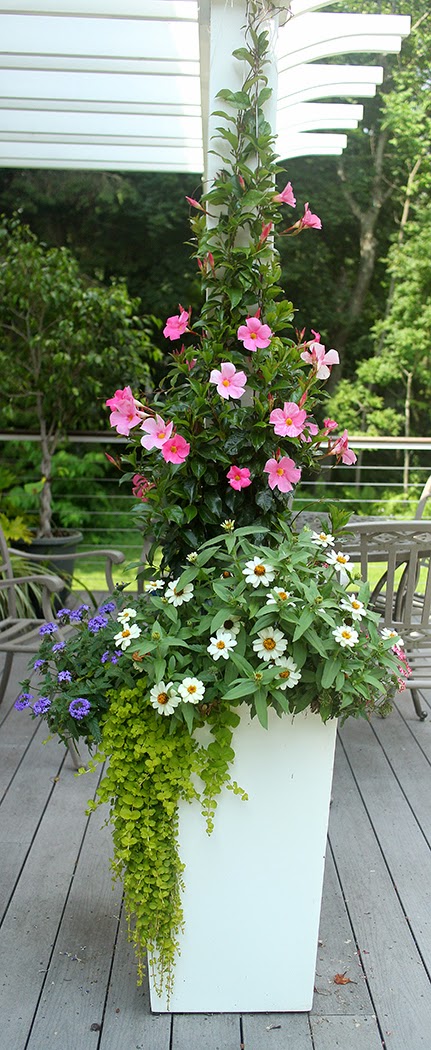
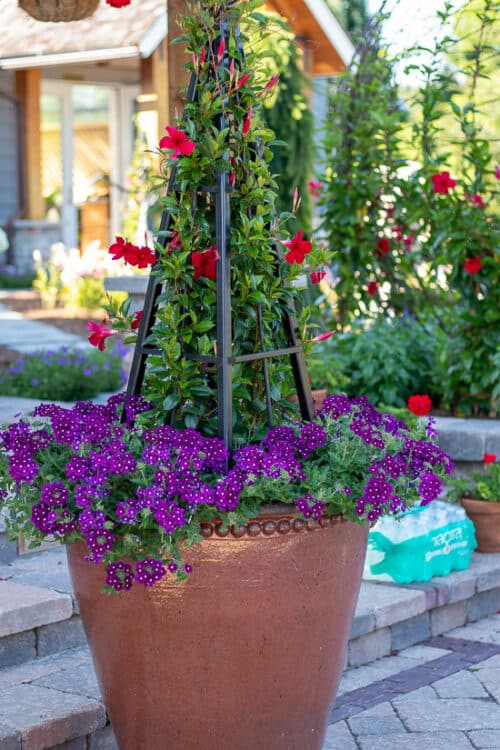
MALABAR SPINACH
I was first introduced to Malabar spinach (Basella alba) at our master gardener plant sale several years ago. And although it’s not widely known, I should have known that container designer extraordinaire Deborah Silver has been using it for years.
It’s not a true spinach, but it is edible and it’s leaves taste a little bit like a buttery spinach. It’s best to eat the young leaves as the older, thicker leaves require a lot of chewing and reminding yourself that they are delicious. The older leaves are deep, dark green and newer leaves emerge a lighter green. That combo is important, because you grow the one for the foliage, as the flowers are rather insignificant little pink balls.
It has pinkish-red stems that twine around bamboo poles or whatever skinny support you give it to grow up.
SWEET PEAS
I’ve written a lot about sweet peas because they are just so darn pretty. And they win the best-smelling flower every day of the week. However, they aren’t big lovers of heat, so they can poop out in the heat of summer, particularly in hotter zones. That makes this one fall into a bit of a different category than the rest of the vines here, but no list of annual vines would be complete without them.
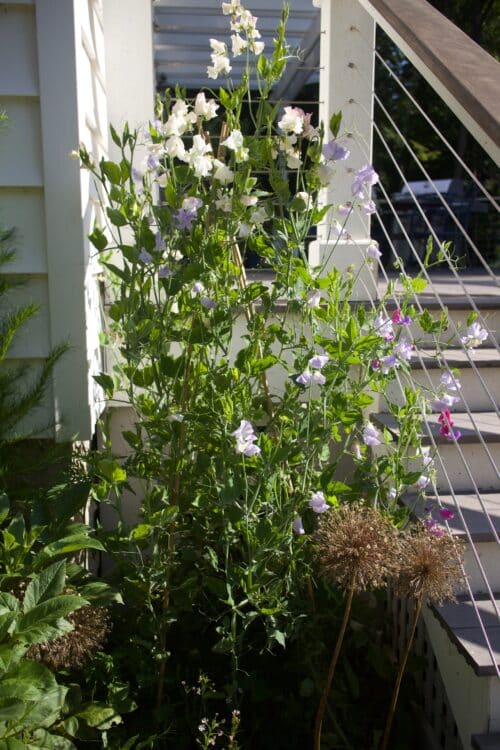
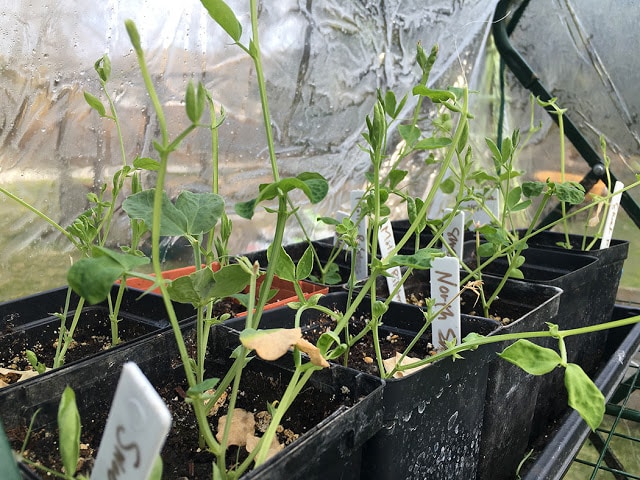
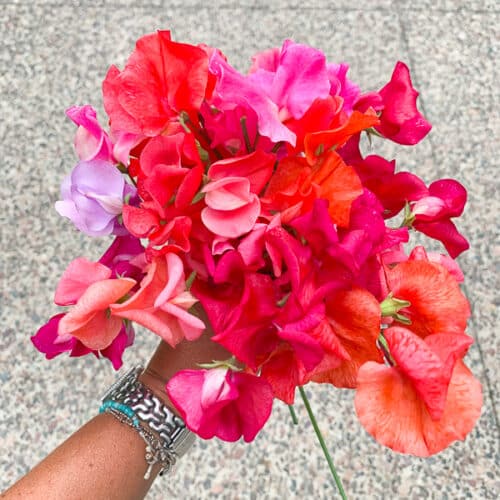
REX BEGONIA VINE aka CISSUS DISCOLOR
Although I’ve not grown this vine before, I plan to this summer. I’m including it on this list because it will grow in bright shade, which makes it a handy plant to have around. You’ll probably look for this one as a plant, but it apparently overwinters well in the house.
There are no flowers to speak of, but the colorful foliage is doing all the work here.
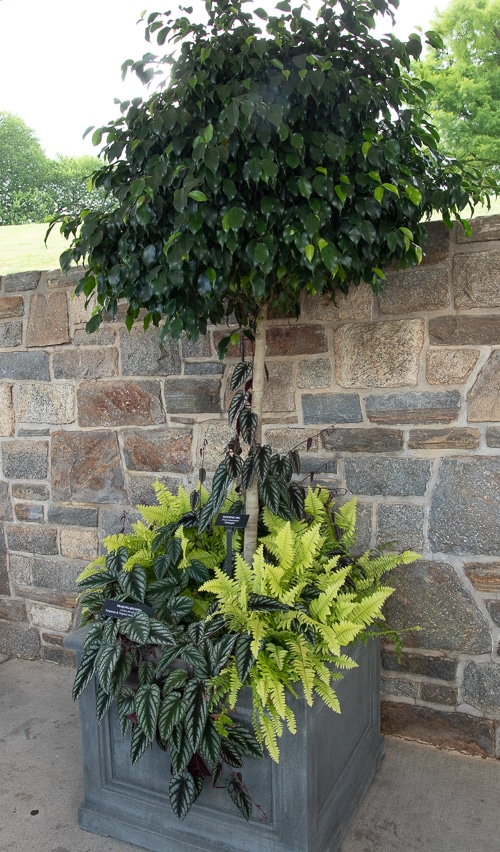
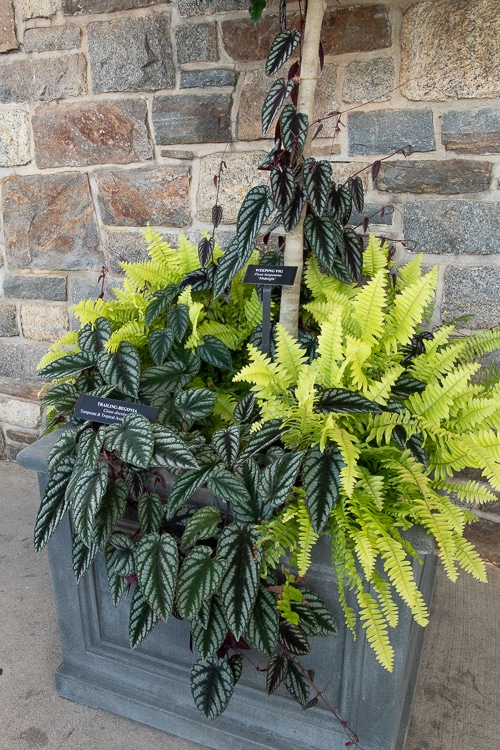
MORNING GLORY
I’ve never grown morning glory because, frankly, I’m a little afraid of it. It is known to be an aggressive reseeder. It also grows aggressively, which can be a great quality. I’ve seen it covering the base of windmills on farms and it’s a lovely cottage accent. And let’s be honest: The flowers are amazing. Large open flowers come in a wide range of colors including perhaps one of the truest blues you’ll find in a flower.
It’s easy to grow from seed, and in fact, I’m not sure I’ve ever seen it sold as a plant. Keep up on the deadheading to keep reseeding at bay.
These two varieties were new introductions from Thompson and Morgan that I saw at California Spring Trials in 2018. There’s no denying these are stunners.
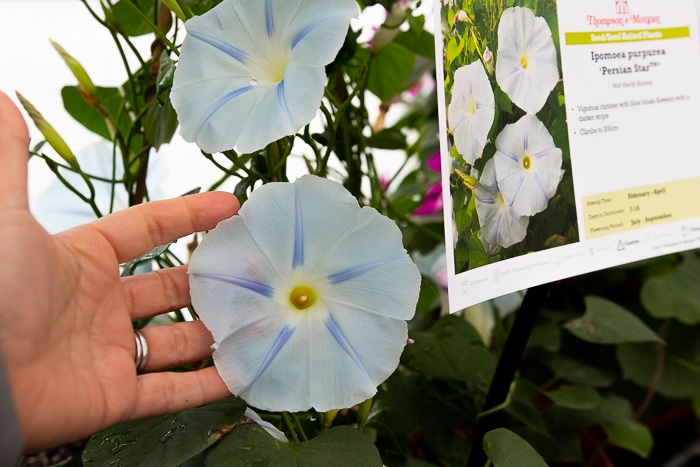
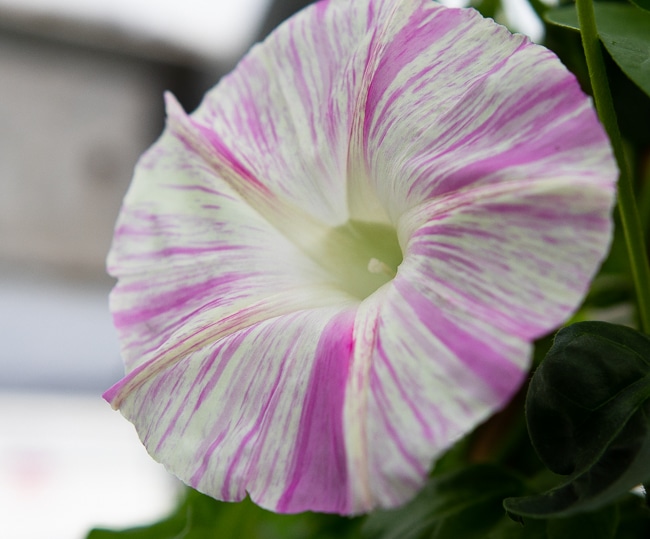
I’ll warn you, once you start growing annual vines, it might be difficult to stop. They are just so handy to have and watching them grow will make you feel like a great gardener.


15 Responses
There is reason to worry about morning glories being a weed–but not Heavenly Blue Morning Glories. These are the signature of my garden. In zone 6a I’ve noticed their bloom time keeps moving back. In 2000 they were blooming by late August. Last year they didn’t start until late September. Now they don’t get enough time to set seed so I never have any volunteers (back in 2000-2005 I’d have a few, but not enough to call it a weed). But the foliage alone with it’s heart shaped leaves is pretty and works wonderfully to provide shade for my porch. They would go OVER your arbor. Moon Flowers are another option. Very similar leaves and growth pattern, but don’t reseed. Their seeds are huge, their blooms are huge. You can actually watch them open in the evening! No diminutive flowers on that one. (Your saucer vine is cute).
I too love annual vines for their vigor and then they go away without yearly maintenance. They are one of my specialty plants that I grow and sell at my local farmers market, always tooting the horn for annual vines. I didn’t see Cardinal Climber mentioned which is a really great one. Ipomea quamoclit covers itself with small red flowers over cutleaf foliage and hummingbirds adore it! Flowers from July through frost here in zone 5 Ohio
Hi Erin,
Could you please tell me the name of that lovely chartreuse fern shown in the photo with the Rex Begonia vine? I’m a sucker for chartreuse anything.
Love our reseeding purple morning glories but we’re zone 4 so maybe that keeps them from being a thug. I also love the white thunbergia but think the pink is my second favorite. Do you have a recommendation for a vine for the shade?
I have been growing Morning Glory for 4 years and it has never reseeded, not a single volunteer (I am in south Ontario). I have never deadheaded it. But my Thunberghia did reseed. However, there were just 2-3 seedlings.
Our favorite annual vine is definitely Morning Glory, though we haven’t grown it for a good while. Thunbergia did not do well for us for some reason, but we only tried it one year. We grew malabar spinach once – the kids hated it as an edible. I would really like to try the Hyacinth Bean Vine, and maybe give Thunbergia another shot.
I never thought about planting annual vines. I like the idea of planting them in a pot and letting them do their thing. You gave me an idea to place a couple of large pots at the base steps of my back deck and then letting the vines grow up the railing! Has anyone done this?
Any good blooms in partial shade? I tried some sweet peas in a spot by my garage and I think it was too shady for them because they were not particularly floriferous.
Hyacinth beans are incredible! We’ve had 10’ of vine on July 4th here in zone 6. They could be a great on your pergola. I’ve got to try cup and saucer soon! Beautiful!
It is so interesting to see what you can grow where you live. I am in the UK and a few of what you consider to be annual vines are treated as conservatory or hot house plants here. Eg. Cissus discolor and mandevillia.
I can grow sweet peas very well though. We do not have enough warmth for the morning glories to flower well and last year was the first time I got the blue one to flower.
I have seen seed for the cobra scandens here so I may try that this summer. Do you sow the seed where it is to grow or sow in trays and plant out?
I am with you about those morning glories. I had the most beautiful pink one with a white stripe one year. It was glorious. The next year it had seeded all over the garden but it wasn’t pink and white. It didn’t come true, it was the dreaded blue one. I haven’t been able to completely eradicate it. I couldn’t believe how many popped up that first year. My cousin just laughs at me when I express my angst about this.
I love the Cissus discolor. I wish I had thought to bring it inside the year I had it. I guess I could try it from seed but no nursery close to me grows it.
I never realized Malabar spinach was vining. I’ve got some seeds so I need to plant those this year. I never have good luck with morning glories. I love them, but they always perform poorly for me so I’ve given them up. This morning, before I saw your post, I ordered several packages of thunbergia seeds of different colors. Can’t wait to see those beauties!
I always grow Morning Glories, and yes they do reseed, but since I love them so much I’m ok with that!
Here’s a new one for you – Gloriosa Lily – I adore that vine – it’s a tuber that you plant, but those flowers are fabulous!
Thanks for the reminder, I must plant my sweet peas under the grow lights – it’s time!
I just installed a new arbor and plan to cover it with vines, I planted sweet peas at base but expect another epoch fail because it gets hot quickly here in coastal NC. I am starting moonvine flowers which you omitted BTW. I love these vines. Heavenly scented and the night moths love them. I have had success with hyacinth beans so I expect that will be my workhorse this summer. Thanks for the list of beautiful vines.
I love annual vines. Ever grow ‘hearts and honey’ morning glory? It’s a cutie.